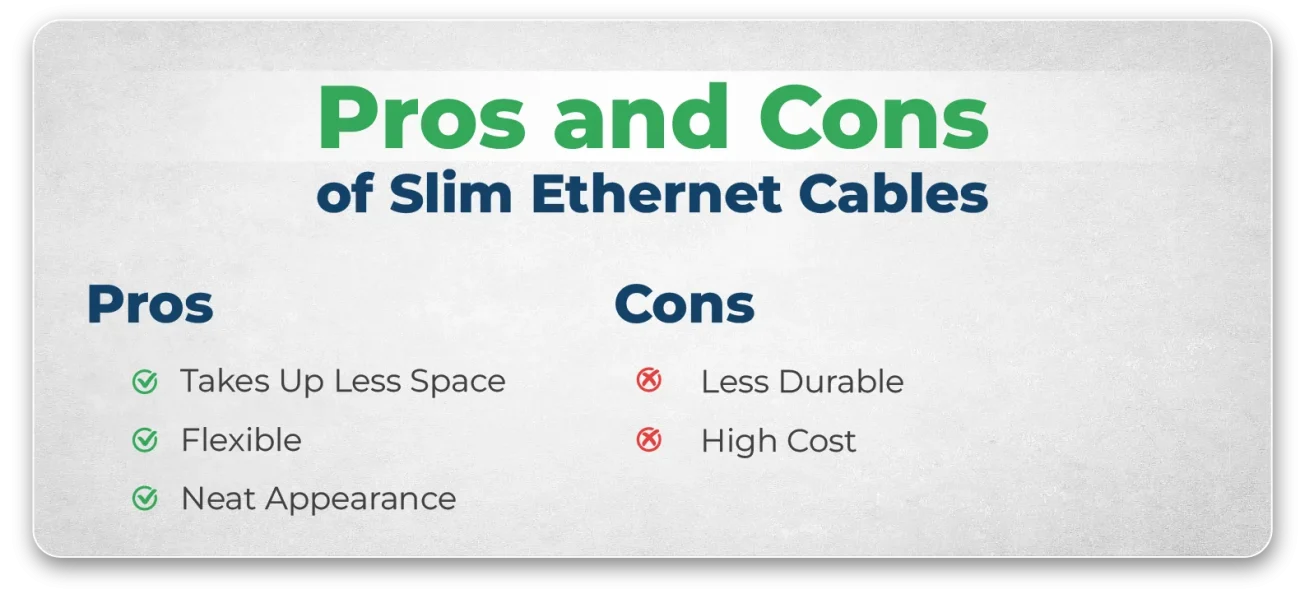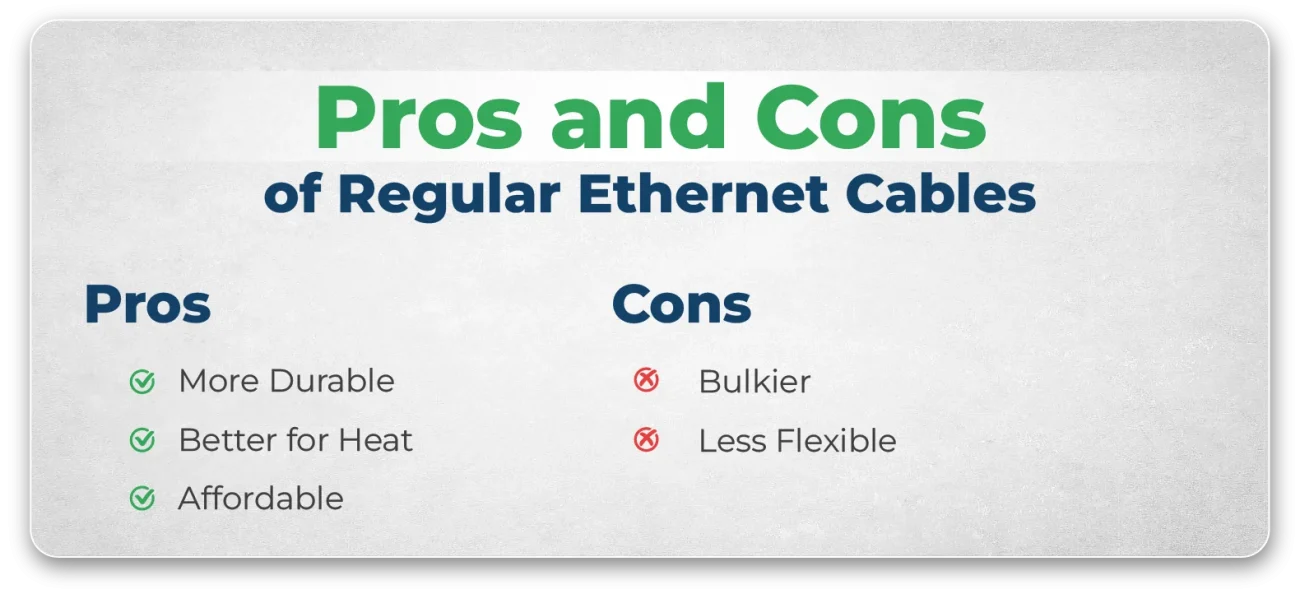Slim Vs Regular Ethernet Cables: Which One Should You Choose?

In today’s world, having a good internet connection is more important than ever. Whether you’re working, gaming, streaming, or connecting with friends, a strong and stable internet connection is key. To make sure everything works smoothly, you need the right ethernet cable. But which one should you pick: a slim ethernet cable or a regular ethernet cable?
Let’s break down the differences between these two types of cables and help you figure out which one is right for your needs.
Table of Contents
What Is a Slim Ethernet Cable?
Slim ethernet cables are newer, thinner versions of the traditional cables you may already be using. They’re designed to be flexible and take up less space, which makes them great for areas where space is limited.
Key Features:
- Thinner: These cables are smaller and easier to fit into tight spaces.
- More Flexible: You can bend and twist them more easily than regular cables.
- High-Speed Support: Slim cables, like the Cat6 or Cat6A, offer the same high speeds as regular cables.
Where You Can Use Them:
- Home Networks: Slim cables are perfect for setting up your home internet in places where regular cables might be too bulky.
- Offices: If you’re running cables behind desks or through walls, slim cables will save you space.
- Entertainment Centers: If you have a home theater or gaming setup, slim cables are easy to hide and keep things looking neat.
What Is a Regular Ethernet Cable?
Regular ethernet cables have been around for a long time and are the standard choice for most networking setups. These cables are thicker and more durable, making them a solid option for environments that require a reliable connection.
Key Features:
- Thicker: Regular cables are bulkier and not as flexible, but they are more durable.
- Better at Handling Heat: Their thicker design helps them handle heat better over long distances or with heavy data use.
- Longer Lasting: They’re built to last longer, especially in environments where cables might get damaged.
Where You Can Use Them:
- Home Network Backbone: If you need a stable and long-lasting connection, regular cables are a good choice for routers and switches.
- Data Centers and Offices: These cables are perfect for long runs and heavy-duty workspaces. Learn how length affects speed

Slim vs Regular Ethernet Cables: Key Differences
Now that you know what each cable is, let’s look at how they compare in key areas.
1. Size and Flexibility
The most obvious difference between slim and regular cables is their size.
- Slim Ethernet Cables: These cables are thinner, i.e., the size of slim cables are 28 AWG, and more flexible, making them easier to fit into tight spaces.
- Regular Ethernet Cables: They are thicker, and the size is 23 AWG. They are more rigid, which means they can be harder to install in tight spots.
2. Speed and Performance
Some people wonder if slim cables affect the internet speed. The good news is that slim cables, especially Cat6 or Cat6A, work just as well as regular cables in terms of speed.
- Slim Ethernet Cables: They can handle high-speed internet, just like regular cables.
- Regular Ethernet Cables: These also support high speeds, depending on the category (Cat5e, Cat6, Cat6A, etc.).
3. Durability
When it comes to durability, regular cables tend to last longer and are less likely to get damaged.
- Slim Ethernet Cables: While they are designed to be tough, their thinner design makes them more prone to wear and tear if not handled carefully.
- Regular Ethernet Cables: They are more durable and can withstand more wear and tear. They’re better for environments where the cables may be exposed to physical stress.
4. Aesthetic Appeal and Space-Saving
Slim cables are great if you want a neat and clean setup.
- Slim Ethernet Cables: Their thinner design makes them less noticeable and easier to hide, which is perfect for people who want to keep things looking tidy.
- Regular Ethernet Cables: These cables are bulkier and not as easy to hide. They are less visually appealing when running through walls or along floors.
Pros and Cons of Slim Ethernet Cables
Pros:
- Takes Up Less Space: Slim cables are perfect for tight areas, making them easier to manage and hide.
- Flexible: You can bend and twist them without worrying about breaking them.
- Neat Appearance: Great for keeping your setup clean and organized.
Cons:
- Less Durable: Slim cables are more prone to damage because they are thinner.
- Cost: They can be a bit more expensive than regular cables.

Pros and Cons of Regular Ethernet Cables
Pros:
- More Durable: Regular cables are thicker and built to last, even in harsh environments.
- Better for Heat: They handle heat better, which is important for long cable runs.
- Affordable: Regular cables tend to be cheaper than slim ones.
Cons:
- Bulkier: Regular cables are harder to hide and take up more space.
- Less Flexible: They can be harder to work with in tight spaces.

When Should You Use Slim Ethernet Cables?
Slim ethernet cables are perfect when you need a compact and flexible solution. Here are some situations where slim cables shine:
- Home Networks: If you want to keep your home internet setup looking neat and tidy, slim cables are a good choice.
- Office Setups: Slim cables work great in smaller offices or places where space is limited.
- Entertainment Systems: For hiding cables behind your TV or entertainment center, slim cables will keep everything neat.
Conclusion
So, which cable should you choose? If you’re setting up a home network, office, or entertainment center and need a space-saving and flexible cable, a slim ethernet cable is your best bet. On the other hand, if you need a durable, long-lasting cable that can handle rough conditions and long-distance runs, regular ethernet cables are the way to go.
Both types of cables have their advantages, so it all depends on your needs. Want to get started on your next network setup? Check out our range of ethernet cables and find the perfect one for you.
FAQs
What is the difference between slim and regular Ethernet cables?
Slim ethernet cables are thinner and more flexible than regular ones. For example, a slim Cat6 cable is about 3.6mm wide, while a regular Cat6 is around 6mm (cat6 cable diameter mm). Slim cables bend easily and fit in tight spots, like behind a TV. Regular cables are thicker, sturdier, and better for long runs or tough conditions. So, slim ethernet cable vs regular comes down to size and how you use them!
Are slim Ethernet cables slower?
Nope! Slim ethernet cables aren’t slower. Both slim Cat6 and regular Cat6 cables can hit speeds up to 10 gigabits per second super fast for gaming or streaming. The slim design doesn’t cut performance; it’s just as good as regular for most setups. Speed’s not the issue it’s about fit and strength.
Is a thin Ethernet cable good?
Yes, a thin ethernet cable (like a slim one) is good for lots of things! It’s awesome if you need to save space or hide cords like under rugs or in small offices. They’re fast and easy to install. But if you’re rough with them or need them for a long distance, they might not last as long as thicker ones. So, they’re great just pick the right job for them.
Are thicker Ethernet cables better?
Not always! Thicker ethernet cables, like regular Cat6, are better for durability and long runs like across a big house. They handle wear and tear well and block signal fuzz in busy spots. But they’re bulky and stiff, so slim cables win for tight spaces or neatness. Slim vs regular ethernet cable depends on what you need thicker isn’t always “better.”
Which Ethernet cable is faster?
Neither slim nor regular wins the speed race they’re equal! Both slim Cat6 and regular Cat6 cables zip data at 10 gigabits per second up to 55 meters. Even fancier ones like Cat6a are the same speed for most home use. So, speed’s a tie focus on size or toughness instead.
Which type of Ethernet cable is best?
The “best” ethernet cable depends on you. For small spaces or a tidy setup, slim Cat6 cables are tops they’re bendy and fast. For big jobs, long distances, or rough spots, regular Cat6 or Cat6a is best because they’re tough and reliable. Ask yourself: “Do I need neatness or strength?” That’s your winner!
